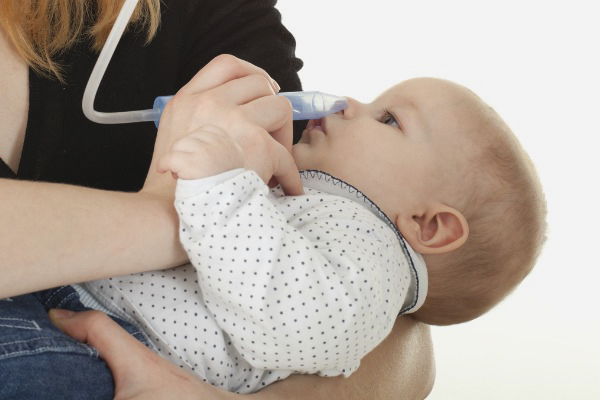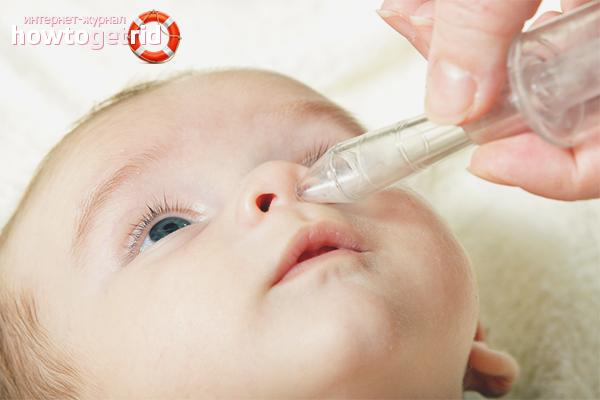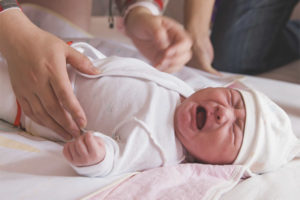The content of the article
Good nasal breathing for a child of the first year of life is very necessary. Physiologically, a small nose is designed so that even a small swelling of the adenoids or mucous membranes makes it difficult for the infant to breathe. Because of this, he constantly wakes up at night, because the mucus flows into the throat and irritates the diaphragm. A baby who cannot breathe through his nose has problems feeding. After all, he can not suck breasts and breathe with his mouth at the same time. Therefore, during feeding, the baby is constantly interrupted, greedily inhales the air, is angry that he cannot eat normally. All this leads to the whims, weeping and restlessness of the crumbs. And how parents experience when they see the child’s condition and cannot help him with anything. Well, can't they blow their nose for a child? And in general, the baby will learn to get rid of mucus in the nose only by two years, or even later.Until that time, parents should learn to suck snot from infants themselves.
Several decades ago, when there were no modern nasal aspirators on sale, young mothers had no choice but to suck snot directly with the mouth. At the same time there was a high probability of infection from the baby. Yes, and pleasant in this way was not enough, agree. Modern products make us happy with effective and safe instruments, with the help of which we can free our children's nozzles quickly and efficiently. So, consider the main types of nasal aspirators for infants.
What to suck snot
A nasal aspirator or nozzle is an indispensable thing in a home where there is a small child. With its presence, the disease is much faster and easier. We will deal with the main types of nozzles.
- Pear or douche. Outwardly, such an aspirator is similar to a rubber bulb, which is used for an enema. The pear is of small volume, and at its end there is a special silicone lining that provides a snug fit to the baby's nostril. The pear is first squeezed, then placed in the baby’s nostril and released.Because of the vacuum created inside the pear gets all the mucus, which interferes with the crumbs. The advantage of this item is relatively low cost. The disadvantage is that “thrust” is often not enough, and mom has to remove the nozzle and “suck” snot through it independently.
- Tube with a reservoir for mucus. The following skimmer works on the same principle. A mechanical nasal aspirator is a tube with some capacity to collect mucus. That is, the soft tip is inserted into the nose of the child, the second nostril closes. From the tip is a small tube at the end of which is a removable filter. Through the second end of the tube, the mother sucks mucus, but it does not reach her mouth, as it settles in the reservoir. Quite an effective and safe way to cleanse the nose. In addition, there is the possibility of regulating the intensity of the suction of mucus.
- Electronic aspirator. It is a small device on batteries. Mom simply inserts the tube into the nostril of the baby and waits - the device will do everything on its own. There is the possibility of controlling the force of retracting. Some models have the function of pre-rinsing the nasal passages.A special reservoir for collecting mucus is built into the device - you can see how much snot left. There are also models that, while running, play certain tunes to distract the child.
- Vacuum aspirator. This is a relatively new type of appliance that works from a regular household vacuum cleaner. The principle is the same - with the help of a vacuum, mucus is drawn out. Do not worry about the fact that the power of the vacuum cleaner is great. A vacuum aspirator regulates power and will not allow injury to the mucous. This is one of the most effective and safe devices. Besides, its cost is small (unlike an electronic aspirator).
These are the main types of aspirators that are popular and in demand from parents today. However, in order to help the child and not to harm him, it is necessary to use the suction device correctly.
How to suck snot in infants
As soon as you notice that the baby has mucus, do not hesitate, but proceed to the procedure as soon as possible.
- First you need to soften the crust in the nose of the child to make it easier to remove. To do this, prepare a weak saline solution - half a teaspoon of salt per cup of warm water. Using a pipette, put 1-2 drops in each nostril of the child.The baby should be in a semi-sitting position. Saline solution not only helps get rid of snot, but also moisturizes the mucous. After all, crusts in the nose can appear not only from viral diseases, but also due to dry air in the room.
- After 10 minutes, when the water softens the mucus, start using the aspirator. Be sure to read the operating instructions before using the device. Clamp one nostril with your finger and insert the soft nozzle into the other. Be careful and hold the nozzle correctly so that the middle of the tube does not rest against the wall of the mucous membrane - this can lead to microtrauma. After cleansing one nostrils proceed to the second.
- Watch the child’s reaction. Surely, he will not like that some object is sticking out of his nose, he will be capricious and show his displeasure. But if the baby cries heart-rending, most likely you are hurting him. In this case, stop your actions and resume them after some time.
- If thick crusts form in the nose, they should be removed with a cotton swab.
- After cleansing the nasal passages, drip the medication that your doctor prescribed.This is justified if the cold is cold. All medicines work much better if they are instilled into a cleaned spout. Do not bury breast milk in your nose. It has long been proven that milk is an excellent environment for the development of bacteria, so this “medicine” will only worsen the situation.
- Clean the baby’s nose as needed. This is usually done every 3-4 hours.
- After use, any aspirator should be thoroughly rinsed and disinfected. If the device has removable disposable tips, do not reuse them.
If the child has a runny nose of an allergic nature, then you should not suck off the mucus, most likely it is not there, and congestion arises due to swelling of the adenoids. In this case, antihistamine medicine will help. It quickly neutralizes the allergen and reduces swelling.
A runny nose in a child is considered a serious problem, because the baby cannot normally eat and sleep due to nasal congestion. In addition, the physiological features of the structure of the children's upper respiratory organs are such that running cold can easily lead to sore throat and even otitis. In addition to suctioning mucus, take measures to get rid of the cold as soon as possible - humidify the air, ventilate the room more often, and keep abundant drinking water.And then the runny nose will go as imperceptibly as it appeared.
Video: how to clean your nose from snot





 5 votes, on average: 3,40 out of 5
5 votes, on average: 3,40 out of 5







To send